- Home
- Stephen E. Ambrose
Supreme Commander Page 11
Supreme Commander Read online
Page 11
One of Eisenhower’s major tasks was to build a staff for Allied Force Headquarters (AFHQ). He chose the American delegation from among planners at ETO. Under the direction of Brigadier General Alfred M. Gruenther, an old friend of Eisenhower’s (and the best bridge player in the Army), the Americans met with their British opposite numbers and began to study British plans already developed. On August 4 they moved over to Norfolk House on St. James’s Square to begin their combined deliberations. On August 10 Clark took command of the planning.
In building AFHQ Eisenhower decided that since both the commander and his deputy were American he would use the American staff system of G-l, G-2, and so on. He also decided that at AFHQ he would follow the principle of balanced personnel, which meant that whenever the assistant chief of staff for an operational staff section was of one nationality his opposite number was of the other and had the title of deputy assistant chief of staff. Below the heads of sections the rest of the personnel was recruited as equally as possible from American and British sources. As Eisenhower noted, “there was no historical precedent upon which to base” the organization of AFHQ, and he considered his decisions in setting up his headquarters as “among the most important and far-reaching … of the campaign.”5
The integration was complete. At AFHQ British soldiers worked in daily contact with American sailors, while Army Air Force officers struggled over problems with British sailors. At first, Eisenhower recalled, they came together like a bulldog meeting a cat, but all realized that the job had to be done and they made valiant efforts to understand each other’s accents, slang usages, and administrative ideas. In most offices the co-operation was so complete that British officers joined their American opposite numbers for a coffee break in the morning, while the Americans joined the British for tea in the afternoon.
The system worked, mainly because of the determination of the participants to make it work, partly because of Eisenhower’s leadership. He was, by his own description, fanatic on the subject of Anglo-American solidarity, and he shipped home immediately any American officer who could not co-operate with the British. When asked, long after the war, about his emphasis on the need for Allied unity, Eisenhower said that he had read a considerable amount of military history and had talked at length about it with Fox Conner. Neither he nor Conner had any respect for coalition commands as they had existed in the past. This was the reason, he added, that he supported the CCS system, for it made it possible for theater commanders to look to one source for orders. The CCS system was as close as one could get, Eisenhower felt, to having one government giving the orders. But even with the CCS, Eisenhower knew that as Allied commander in chief he had an enormous responsibility to make the alliance work.6
Soon after AFHQ came into existence, General Hastings L. Ismay, Churchill’s Chief Staff Officer and a member of the BCOS, reported to Eisenhower that he had heard of an American officer who when drinking boasted that the Americans would show the British how to fight. Eisenhower “went white with rage.” He summoned an aide and told him to arrange for the officer in question to report the next morning. As the aide left the room, Eisenhower hissed to Ismay, “I’ll make the son of a bitch swim back to America.” The officer was sent home—by boat. Sometime later, Eisenhower learned of a fracas between an American and a British officer on the AFHQ staff. He investigated, decided that the American was at fault, ordered him reduced in rank, and sent him back to the States. The British officer involved called on Eisenhower to protest. “He only called me the son of a bitch, sir, and all of us have now learnt that this is a colloquial expression which is sometimes used almost as a term of endearment.” To which Eisenhower replied, “I am informed that he called you a British son of a bitch. That is quite different. My ruling stands.”7
AFHQ’s initial problems were not only in the area of national prejudices. It was almost as difficult to force soldiers and sailors to work together as it was British and American officers. Eisenhower had asked King for two of the U. S. Navy’s most capable officers to serve on the staff. When they arrived on August 10 they were welcomed with the statement that there were a thousand questions the Navy could answer. One of the officers replied, “We are here only to listen.” Eisenhower was furious. He said that if King himself were in London there would be no difficulty, “but we have a one-man Navy.” Eventually the Navy officers pitched in and did their share, but it took time.8
Given Eisenhower’s own professional experiences and the practice in the American Army, it was inevitable that he should regard the choice of his chief of staff as crucial. The man he wanted was Brigadier General Walter Bedell Smith, whom Eisenhower had known in the War Department as Secretary of the General Staff, but Marshall wanted him to stay in Washington. The tug of war did not end until the first week in September, when Marshall finally allowed Smith to join Eisenhower in London. By then Marshall realized that TORCH was going to go, and that Eisenhower would command it. For the first American offensive in Europe the Chief wanted his commander to have the best.
Smith remained with Eisenhower throughout the war. He was close to indispensable. His square jaw and Prussian appearance dominated Eisenhower’s headquarters. He decided who could see Eisenhower and who could not, handled much of Eisenhower’s civil affairs and diplomatic duties, had almost unlimited responsibility and authority in all matters except promotion of officers and operational directives, was the “no” man in the office, and frequently represented Eisenhower at meetings. Sir Ian Jacob, Ismay’s deputy, thought Eisenhower was lucky to have Smith, because Smith was tough while Eisenhower used to bend somewhat with the wind. Eisenhower trusted Smith completely and regarded him as a “godsend—a master of detail with clear comprehension of the main issues.” Years later Eisenhower said he was like a crutch to a one-legged man.
Smith was also, as Eisenhower politely expressed it, “strong in character and abrupt by instinct.” Or, as he put it more directly to a British officer, “Remember Beetle is a Prussian and one must make allowances for it.”9 Smith suffered from an ulcer, and although he could be suave and conciliatory when on a diplomatic mission, he was a terror in his own office. He reduced his subordinates to a bundle of shaking nerves. Once when he was holding a conference in his office his secretary, Ruth Briggs, a gracious lady who later ran for governor of Rhode Island, stuck her head in the door. Smith bellowed, “Get the hell out of here.” Without pausing for breath, and before the startled Miss Briggs could withdraw, Smith turned to the officers around the table and declared, “You’ll have to excuse her, gentlemen. She’s an idiot.” He then picked up the conversation exactly where he had left it.10*
Smith’s most important duty was to be the channel through which the assistant chiefs of staff communicated with Eisenhower. He handled them without strain or fuss. Smith “is a natural-born chief of staff and really takes charge of things in a big way,” Eisenhower told Gailey right after Smith arrived. “I wish I had a dozen like him. If I did, I would simply buy a fishing rod and write home every week about my wonderful accomplishments in winning the war.” Smith had two deputies, General Gruenther and the British Brigadier John F. M. Whiteley, who like Smith stayed with Eisenhower through the war. One of Smith’s first acts was to add to Eisenhower’s organization a new section, the Secretary, General Staff (SGS). Because he had held the same post himself under Marshall, Smith knew exactly what he wanted from SGS and was so demanding that he tried five different men in the office and was never satisfied—except once, and that officer came to Eisenhower and begged to be sent out of the theater because he could not stand working for Smith. An astonished Eisenhower explained that he was the first SGS to impress Smith, but the officer insisted upon leaving. The function of SGS was to maintain an office of temporary record, receive and record all proposals of new policies or changes in existing policies, directives, and operations plans, to route papers to their proper destinations and to ensure prompt action on them. SGS was the cement holding the headquarters together.11
<
br /> On the operational side Eisenhower’s major worry was the degree of control he would have over the fighting forces. British and American air, ground, and sea forces would be making three widely separated landings, each under a naval officer while at sea and a soldier when they hit the beaches. Eisenhower wanted all the strings to lead up to him. “Alliances in the past,” he observed, “have often done no more than to name the common foe, and ‘unity of command’ has been a pious aspiration thinly disguising the national jealousies, ambitions and recriminations of high-ranking officers, unwilling to subordinate themselves or their forces to a commander of different nationality or different service.”12 That this was a danger in 1942 became clear when the BCOS dug out Marshal Foch’s old directive of April 3, 1918. Foch had been charged “with the duty of coordinating the action of the Allied Armies on the Western Front” and had “strategic direction of military operations.” The British, French, and American Armies continued to exercise “in full the tactical conduct of their armies,” and each had “the right to appeal to his Government, if in his opinion his Army is placed in danger by any instructions received from General Foch.”13
In their first directive to the British ground force commander, the BCOS strengthened but did not essentially change the old Foch directive. On the crucial point, the British general still had the right to appeal an order of Eisenhower’s to his government if he thought his army was placed in danger by it. Eisenhower protested, and the BCOS responded handsomely. Under their revised directive, the British ground force commander was told that Eisenhower was his commander and “you will carry out any orders issued by him.”14
Concurrently with the organization of his headquarters and the establishment of unity of command, Eisenhower got on with the task of selecting his field commanders. For the head of the American Army forces he wanted Major General George S. Patton, Jr., an experienced cavalry and armored officer who was an old friend. Patton was Eisenhower’s senior and back in 1940 Eisenhower had hoped to command a tank unit under him. Now he sought to get the flamboyant, unpredictable Patton to serve in TORCH. Patton was widely regarded as an officer who caused more headaches than he was worth, but Eisenhower was willing to put up with almost anything from Patton in order to reap the benefit of his fighting qualities. A handsome man who dressed expensively and who usually put on an act for dramatic effect, Patton liked to wear flashy pistols on his hips, used obscene language in his high, squeaky voice in any company, bragged incessantly, and had vague ideas about being the reincarnation of earlier generals. Independently wealthy, with no problems of personal security, he was embarrassingly outspoken, especially on political subjects, about which he was hopelessly naïve. But Eisenhower was willing to take all this because he recognized that most of it was an act and that Patton’s “one ambition was to be a great soldier.”15
For his British commanders, Eisenhower turned to “Pug” Ismay for help. On August 6 he asked that the BCOS name an air commander and a naval commander so that work could go forward. They had already assigned the ground commander, General Sir Harold Alexander, one of Churchill’s favorites. Before the month was out, however, Churchill had decided to shake up the Middle East command and put Alexander in charge there. His replacement was General Montgomery, but when the commander of the Eighth Army in the Middle East died in an airplane crash, Churchill sent Montgomery to Egypt. Eisenhower ended up with Lieutenant General Sir Kenneth Anderson, a Scot who—everyone assured Eisenhower—had a fine reputation. If Eisenhower was irritated when the British sent their first team to Egypt while leaving him with the substitutes, he never complained about it.
In any case, Eisenhower did get the best the Royal Navy had to offer. The BCOS assigned Admiral Sir Andrew B. Cunningham to command the British naval forces in TORCH, with subordinate commanders for each of the three landing forces. Cunningham was the embodiment of the traditions of the Royal Navy, a man of enormous dignity, efficient and cool in action, whose only thought was to send his ships out in order to fight and sink the enemy. Eisenhower came to admire, almost to the point of adulation, many of his British associates, but none ever made quite the impression upon him that Cunningham did. He was, Eisenhower felt, “vigorous, hardy, intelligent, and straightforward … a real sea dog.” Later in life, when asked about a man, Eisenhower would use Cunningham as a standard. Thus Ismay was “almost as good as Cunningham.”16
Under the arrangements, Eisenhower had direct contact with his two ground commanders, Anderson and Patton, but he dealt with naval commanders through Cunningham. The air forces organization followed that of the ground forces. There were two groups, the Eastern Air Command composed of RAF units under Air Marshal Sir William L. Welsh and a Western Air Command under Brigadier General James H. Doolittle, already a legend because of his raid on Tokyo. Doolittle’s force was known as the Twelfth Air Force and consisted primarily of units he took from the Eighth Air Force in England. Both Welsh and Doolittle reported directly to Eisenhower.
With his staff picked and functioning and his commanders selected, Eisenhower could give his full attention to operational planning. It had been going along at a brisk pace; as Eisenhower later pointed out, “Any narration of the problems that faced us during the late summer and fall of 1942 must take them up in turn; but solutions had to evolve together.… [Everything] had to be handled progressively and simultaneously. Difficulty in [one area] produced at once difficulties in all the others.”17 But organization came before all the others. As Butcher noted, “Ike is most worried when he is uncertain about an organizational pattern. Once the pattern clarifies in his mind, his brow unwrinkles.”18 With his organization set, Eisenhower could concentrate on the transatlantic essay contest.
In planning the grand strategy of 1942 the Americans had been bold, the British cautious. When the time came to work out in detail the plans for Operation TORCH, the British were prepared to take great risks while the Americans advocated the safer course. Although by mid-August the CCS had not written Eisenhower’s directive and had not yet set an objective, clearly the aim of TORCH was to drive the Axis from North Africa. Half of the North African coast belonged to a neutral, Vichy France. Axis possessions began with Italian Libya and extended on to Rommel’s lines in Egypt. To drive the Axis out, the Allies had to go through French Morocco, Algeria, and Tunisia. Enormous distances were involved; it was nearly a thousand miles from Casablanca on the Atlantic coast of Morocco to Algiers, another four hundred from Algiers to Tunis. The Allies had to expect, in addition, that TORCH would lead the Germans to pour troops into Tunis, which they could reach from Sicily, Sardinia, and Italy with relative ease. The Allies could hope that Vichy would resist German movements into French North Africa, but they could hardly count on it in view of the German domination of Marshal Pétain’s government.
Tunis was the main prize. With it Eisenhower’s troops could launch operations into Libya against Rommel’s rear, without it they would have to fight in the mountains of Tunisia and Algeria against an enemy operating with an excellent port close to his main source of supply. The Allies could reduce the distance they had to advance by landing as far east in the Mediterranean as possible, thus placing themselves closer to Tunis and giving them at least a fair chance of getting the city before the Germans could react. The problem was Spain. General Franco had so far resisted Hitler’s urgings that he join the Axis but, given his Fascist sympathies and his concern over Spanish Morocco, it was entirely possible that he might come into the war when the Allies invaded North Africa. Spain could take Gibraltar, close off the Mediterranean, and provide the Germans with air bases from which they could pound the Allied troops in Algeria. The result would be disaster. The way to reduce, even eliminate the threat was to take Casablanca, a good port with a railroad line running to Algiers, and make it the major supply depot. This would provide a secure, if lengthy, supply line.
The planners in OPD were more impressed by the dangers than they were by the possibilities and proposed to take Casablanca
, seize the railroad to the east, secure all the approaches to Gibraltar, and consolidate the position in French Morocco before moving eastward into Algeria. They estimated that the program would take three months. Planners in the British armed services had a different idea, brought about because they were responding to a different urgency. For the Americans the main object of TORCH was to get troops into action, and as far as they could see it really did not matter much to the President where or against whom they fought. For the British, the objective was to free North Africa, which meant in practice to drive Rommel out of the continent. They therefore advocated the bold course, driving deep into the Mediterranean with the initial landings and seizing Tunis. The American plan horrified them. There was no point to the operation if three months were frittered away consolidating positions a thousand miles from Tunis while the Germans established themselves there. Such a result would make Rommel’s position stronger, not weaker.
In the debate the British stressed the relative softness of the Algerian coastal area as compared with Casablanca. Algeria had more favorable weather and tide, more numerous and better ports, and was of course much closer to Tunis. At Casablanca the surf was enormous, so high that even the Americans admitted that on four days out of five it would be impossible to land there. The British also argued that landings at Casablanca would threaten Spanish Morocco and thus be more likely to bring the Spanish into the war.19

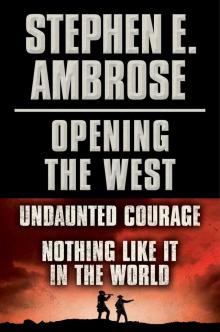 Undaunted Courage
Undaunted Courage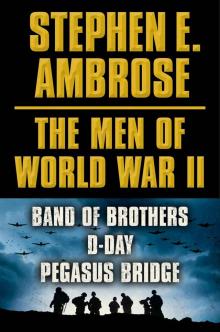 The Victors: Eisenhower and His Boys
The Victors: Eisenhower and His Boys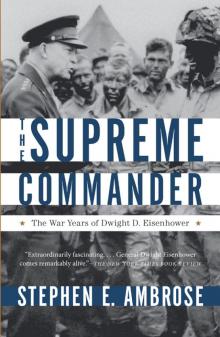 The Supreme Commander
The Supreme Commander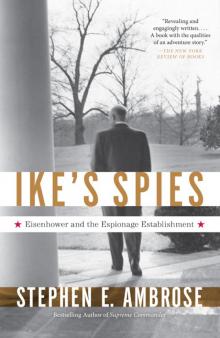 Ike's Spies: Eisenhower and the Espionage Establishment
Ike's Spies: Eisenhower and the Espionage Establishment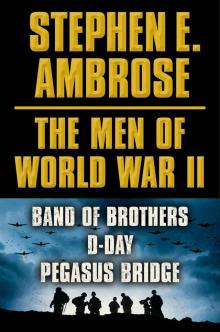 The Men of World War II
The Men of World War II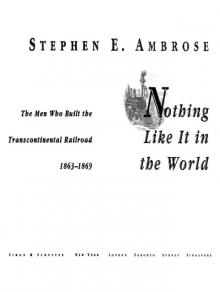 Nothing Like It in the World The Men Who Built the Transcontinental Railroad 1863-1869
Nothing Like It in the World The Men Who Built the Transcontinental Railroad 1863-1869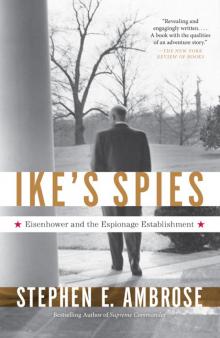 Ike's Spies
Ike's Spies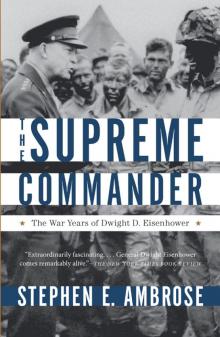 Supreme Commander
Supreme Commander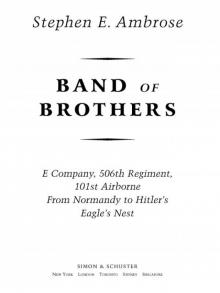 Band of Brothers
Band of Brothers